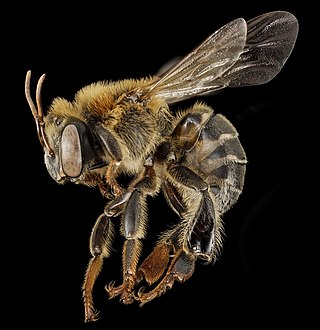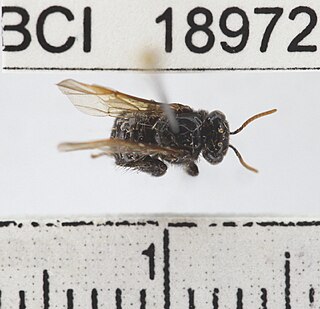
Carpenter bees are species in the genus Xylocopa of the subfamily Xylocopinae. The genus includes some 500 bees in 31 subgenera. The common name "carpenter bee" derives from their nesting behavior; nearly all species burrow into hard plant material such as dead wood or bamboo. The main exceptions are species in the subgenus Proxylocopa, which dig nesting tunnels in suitable soil.

The Eucerini are the most diverse tribe in the family Apidae, with over 32 genera worldwide that were previously classified as members of the family Anthophoridae. All species are solitary, though many nest in large aggregations, and large "sleeping" aggregations of males are found occasionally. Most genera are distinctive in the unusually long male antennae from which the tribe derives its name. They are most diverse in the Western Hemisphere.

Plebeia is a genus of mostly small-bodied stingless bees, formerly included in the genus Trigona. Most of the ~45 species are placed in the subgenus (Plebeia) (s.s.), but there also are four species in the subgenus (Scaura). They differ in only minor structural details, primarily of the hind leg, from other genera that were formerly treated as constituents of Trigona. In some classifications, the genus Schwarziana is treated as a subgenus within Plebeia, but recent morphological analyses indicate that Schwarziana is a distinct lineage, while Plebeia is paraphyletic.

Schwarziana is a relatively small genus of South American stingless bees. Like other stingless bees, Schwarziana are eusocial, with large colonies primarily composed of workers and one queen. Unusually for stingless bees, colonies are formed in underground chambers rather than in tree cavities. Workers are approximately 6.5mm long

Melipona is a genus of stingless bees, widespread in warm areas of the Neotropics, from Sinaloa and Tamaulipas (México) to Tucumán and Misiones (Argentina). About 70 species are known. The largest producer of honey from Melipona bees in Mexico is in the state of Yucatán where bees are studied at an interactive park called "Bee Planet" which is within the Cuxtal Ecological Reserve.

Eufriesea is a genus of euglossine bees. Like all orchid bees, they are restricted to the Neotropics.

Lestrimelitta is a genus of stingless bees found in the Neotropics, from Mexico to Brazil and Argentina, with about 20 known species. They are small, shining black species from 4 to 7 mm in length, with rounded heads and reduced pollen baskets. Unlike most eusocial bees, they do not gather their own pollen and nectar from flowers, thus are not pollinators, but instead they invade the colonies of other stingless bee species and rob their pollen and honey stores. They do not initiate their own nests, but they will "evict" another stingless bee colony from its nest, and convert the pre-existing nest to house their own colony.

Anthidiini is a tribe of insects in the family Megachilidae. There are at least 40 genera and 840 described species in Anthidiini. There is strong evidence that the tribe is monophyletic.

Dianthidium is a genus of leafcutter, mason, and resin bees in the family Megachilidae. There are at least 20 described species in Dianthidium.

Partamona is a genus of stingless bees in the family Apidae. Herbert Ferlando Schwarz in 1938 described the genus. The genus is found from Mexico to Brazil.
Leurotrigona is a genus of bees belonging to the family Apidae.
Dolichotrigona is a genus of bees belonging to the family Apidae.
Camargoia is a genus of bees belonging to the family Apidae.
Scaptotrigona is a genus of bees belonging to the family Apidae.
Trichotrigona is a genus of bees belonging to the family Apidae.
Trigonisca is a genus of bees belonging to the family Apidae.

Tetragona is a genus of bees belonging to the family Apidae.
Ptilotrigona is a genus of bees belonging to the family Apidae.

Oxytrigona is a genus of bees belonging to the family Apidae.
Geotrigona is a genus of bees belonging to the family Apidae.











